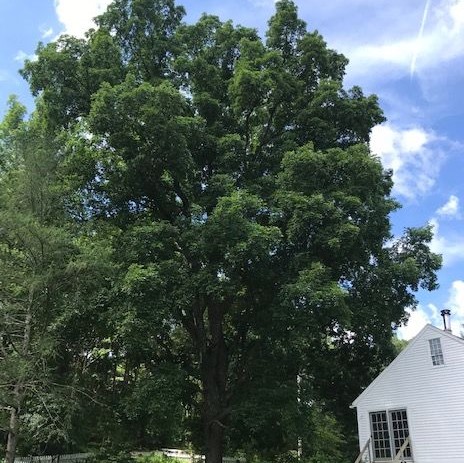7 Questions to Ask When Deciding to Remove a Tree

Deciding when to remove a tree is challenging for homeowners. Many factors, including the cost of tree work and any emotional ties to the tree, can impact the decision to remove a tree. A dying tree that doesn’t present hazards to people or property can be allowed to die in place without any human intervention.
But hazardous trees with structural weakness that endanger people and property need immediate attention. Below are seven questions to help you decide if you need to remove a tree. Don Sepe, Sepe Tree Service, a licensed and certified tree removal company, answered the questions.
1. Does the green stuff growing on my tree mean it’s dying?
No. That’s lichen. Lichen is a slow-growing plant that appears on walls, rocks, and trees. It’s not parasitic. It proliferates when exposed to full sunlight, which explains its profusion on dead trees. That often indicates that the air nearby is relatively pure. Most lichens won’t grow in a smoky or polluted atmosphere.
2. Do large dead branches indicate that a tree is dying?
Not necessarily. Large dead branches endanger people and property. If less than 25% of the tree’s branches are damaged, the tree can survive. Remove any crossed or rubbing branches. Narrow branch angles—especially those on the main trunk—are prone to splitting. Remove these branches as well. These procedures are best done by an arborist.
3. Is there trunk damage?
Internal decay in a tree often appears as vertical cracks, seams, dead branch stubs, and large, older wounds. If the tree has less than 25% damage to its trunk, the wounds can gradually heal without permanent injury. If the tree has more than 25% damage to its main trunk, you should remove it.
4. Is the tree hollow?
Many trees can live for years with hollow trunks. That’s because the connective tissue of the tree—its xylem and phloem—are on the outer edges of the tree. The hollowness, however, compromises the trunk’s strength, making the tree a danger to people and property. So, remove the tree if one-third or more of the tree’s interior is hollow.
5. Are there large dead branches?
Trees with large dead branches endanger people and property. So, do trees with broken tops. If less than 25% of the tree’s branches are dead, the tree can survive. Remove any crossed or rubbing branches. Narrow branch angles, especially of the main trunk, are also a concern. They’re prone to splitting. If a narrow crotch is too large to remove the two co-dominant leaders, cable them to relieve the strain and prevent them from breaking down. Contact an arborist to perform these procedures.
6. Our tree is close to our house. Should we remove it?
Trees near a house can present a problem to homeowners, but you don’t always need to remove them. You can “crown raise” a tree to supply about 12-15 ft. of roof and house clearance. That keeps mold from growing on your house and prevents squirrels from jumping to your roof and nesting. You can also use tree growth regulators (TGR), which help control tree and shrub growth. TGRs keep the tree trimmer. Have an arborist come out and look at the tree and help you decide.
7. Should I call an arborist to do my tree work?
Hiring an arborist to remove a tree is the safest and most cost-effective way to remove a tree. If you use your landscaper to remove the tree, however, make sure that he or she has the proper insurance to do the job. Landscape insurance doesn’t cover staff working at heights over 8 feet in the air. So, if an accident happens, you could be liable for any damage. No one wants that.
Answering these seven questions can help you decide whether to remove a tree. If you’re still not sure, talk with an arborist. He or she can help you make the right decision. If you need to remove a tree, use a professional tree removal service. It’s the best, most cost-effective approach to tree removal.
Sepe Tree Service is a full-service tree care company. Its owner, Don Sepe, Jr., has over 30 years of experience in tree removal and stump grinding. Sepe Tree is available 24 hours a day for emergency service. For more information, call 401-276-2828.



